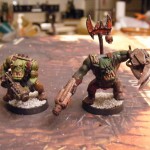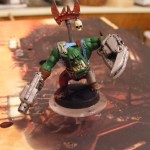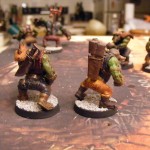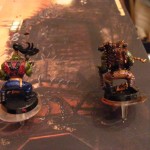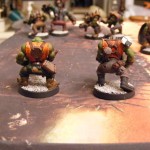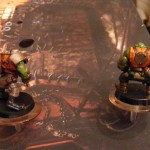Musings on Business Models: Games Workshop Main Line games.
I play many games. These games are made by companies. These companies have business models that want you to buy their miniatures and rulebooks. These business models can directly effect the rules of the game they are selling. Technically, two of the business models I’m going to describe are for one company. I will briefly describe the business models behind Games Workshop’s main line games, 40K and Fantasy. I’d love to do multiple games in one post, but I don’t want my post to be that long.
Games Workshop: 40K and Fantasy – the Codex/Army Book model.
For both of their main line games, Games Workshop follows the following model. For an edition, they release a main rulebook with all of the rules to play a game, but not the rules to allow each army to make a playable list. They then release army books that work with the main rules to make army lists. They build hype for each new book, and release an initial wave of minis with the book, followed by diminished waves later.
Pros: This method makes money. Each newly released (or updated) army sells a bunch of minis for people who hear about the new book and want to play the new army. This also keeps the game updating at a brisk schedule. GW tends to alternate books for 40K and Fantasy, so every two months (on average) a new book comes out. The game rules also don’t stagnate, as players must adapt to the bells and whistles of the newest kid on the block.
Cons: One of the reasons armies sell so well after a new book is released is because of the phenomenon known as “Codex Creep.” This basically says that the newest army tends to be the most powerful. While not entirely true, (few recent 40K codexes come close to the ball-breaking power of the Imperial Guard codex) each new book does tend to have some incredibly powerful abilities. This means that there is a noticeable trend towards more and more power, until the edition becomes broken.
A good example is the new Space Wolves codex. Compare it to the slightly earlier Space Marine codex. Tactical marines and Grey Hunters are comparable in price. Tactical marines must take a Sergeant for 10 more points per squad, and this Sergeant has options for various weapons. The Tactical marines can also take one special weapon and one heavy. They are limited to a squad size of 10, just enough to fit in a Rhino. Tactical Marines also have the Combat Tactics special rule, which is very handy when the squad is bring shot at and about to be assaulted. On the other hand, the Grey Hunters do not have the option of a sergeant. They can, however, take some weapons on regular Grey Hunters. They do not have an option for a heavy weapon. Three things make the Grey Hunters a better choice. First, they trade Combat Tactics for Counter Charge. Combat Tactics is only useful when a squad is in trouble, but Counter Charge is useful even when the squad is intact. Space Wolves get into close firefights, and dare the remnants of the enemy to charge them. Second, Grey Hunters can take a banner in each unit that allows them a once-per-game ability to re-roll “1”s in close combat, and it’s only 10 points. Third, and most important, Grey Hunters have a Bolt Pistol, CCW, AND Bolter. This means they can fire their bolters on Rapid fire, get charged next turn, and have 2 attacks each, or 3 if their Counter Charge works. What ever happened to the good old True Grit? The end result is that balance goes right out the window in favor of selling models. However, this does keep the cycle going, so the game doesn’t die.
This also means that more popular armies tend to get more attention. Take a look at the history of 40K books to see how many Space Marine variant books have been released since the advent of 4th ed. Space Marines sell, so they get more books, while less popular armies get books less often. This is actually a detriment to the game, not because Space Marines are bad, but because other armies are good. Look at the Orks. The 3rd ed Ork codex was competitive during 3rd ed, but half of the entries were utterly useless. Post a comment if you played 3rd ed Orks and unironically took Lootas with sniper rifles, or Stikkbom Boyz. Orks were relatively unpopular during late 3rd and 4th because newer books were better. Then the newest Ork codex came out late 4th ed. Very few units were useless (Big Gunz, anyone?) and the Orks not only got a well written book, but a powerful new list. Ork sales immediately increased. It’s not that people didn’t like Orks, it’s that people didn’t like the crappy 3rd ed book with its one-trick list. It took almost a decade for Orks to get one update. In that time, the Space Marines and their variants got a bunch. It’s even worse if you look at the time discrepancy for the Dark Eldar.
Verdict: Yes, GW’s main line business model has some serious downsides. It doesn’t promote game balance, and tends to give more attention to popular armies. However, this model keeps a giant like GW going. The constant releases keep new models coming out, and most of these are pretty good. So, if you like the game you learn to deal with every Tyranid army containing the Doom of Mal’an’tai in a mycetic spore. Or Space Wolves with three Long Fangs squads with 8 missiles. Or combined Guard/Inquisitor mounted Leafblower lists. Stay out of tournaments and play locally if you don’t like that.
Memorable Games – The Fall of the Myridian Suns
Everyone has games that were so awesome, they’ll never forget them. This could be because of a victory that makes a story worth telling, or a loss that is so hilarious you can’t help but smile. I’ll be posting reports of games I’ve had that went down in the history books.
Back in the old days of Studio 40K in Mary Mayo hall, one of my fellow players was Dan. He answered as easily to his own name as he did to “Rock Star.” He was sort of a hipster. He played mostly Tau, but also had a Space Marines chapter of his own making, called the Myridian Suns. They were Sunburst Yellow with black rims and a black sun with eight rays coming out of it. I was playing against his Myridian Suns with my Azure Flames Space Marines.
Most of the details of the battle are lost. However one important fact was that I took a 5 man Devastator squad with 4 Lascannons, and they deployed in a central ruined building with lines of fire to many different parts of the board. Dan got the first turn and made these Devastators a priority. His entire army unloaded, and killed all but one Lascannon.
Undeterred, the Lascannon made his morale check and proceeded to blow up a Land Raider.
The rest of Dan’s army advanced, and my army and his slugged it out. However, he took the loss of the Land Raider personally and chose to fire a large amount of his army at this lone Lascannon Devastator. He amazingly survived, accounting for (by the end of the game) The Land Raider, a Dreadnought, and some Terminators. This annoyance distracted Dan, and let me outflank him. I named the Lascannon marine Brother Stephen and painted his shoulder rims gold and promoted him to the 1st company. Here is a story I wrote a while ago. After this game, Dan sold off his Myridian Suns piecemeal, and so I thought that they had turned to Chaos and been exterminated.
Brother Stephen’s service during the fall of Myridia.
The Land Raider exploded, spraying shrapnel. Stephen smiled. A bolt round ricocheted off of Stephen’s helmet. The window he was firing from partially disintegrated under the hail of fire from the traitors. Stephen calmly knelt and replaced the battery pack in his Lascannon. A groan from the corner signified that Sergeant Xin’s wound was serious but not fatal. Stephen stood and sighted for another target. He dodged to the right quickly as a Krak missile flew through the space where his head was, and blew out the ceiling three meters behind him. He sighted a Dreadnought and fired. Fire ripped through its Sarcophagus, and it collapsed in a pile of slag. He once again took cover as more of the wall disintegrated around him. The traitor chapter was throwing all their firepower at him. Stephen put that thought out of his mind, stood, and sighted once again. Five Terminators advanced on the building Stephen occupied, their garish yellow livery now decorated with signs of the ruinous powers. Stephen cursed them as he fired, and one fell. They would reach him, but he would take as many of the Myridian Suns with him as he could. The Terminator’s Storm Bolters barked fire, and Stephen had to move to the next window. Shots rang off of his greaves. Stephen uttered a prayer of thanks and fired again, felling another Terminator.
“For Atrus’ sake, get down Stephen!” Xin coughed. He seemed to be staring off into the distance. Another Krak missile blew out the wall, and Stephen had to heave a large piece of rubble off of himself.
“You should not be moving about sir. Let me take care of the traitors.” He replied.
“No, you don’t under…” he cut off, hacking blood. “…Vindicators!”
Stephen’s eyes went wide, and he gently set his Lascannon down, walked to Sergeant Xin, lifted him, and moved him to the center of the building as thunderous booms seemed to tear the world apart. Minutes later his vox link came to life.
“Surviving Azure Flames, this is Captain Valerien. Report.” Several other squads reported in. The traitors were in retreat and their lines had been shattered.
“10th squad 5th Company reporting. This is Brother Stephen. Sergeant Xin is injured and the rest of the squad is dead. We are in hab complex J on the west side of the encampment.”
“Stephen, Valerien. Confirm hab complex J?”
“Valerien, Stephen. Confirmed.”
“Excellent work, Brother. Your squad seemed to draw the fire of all the traitors at once. Your distraction allowed our Vindicators to get into position, and your fire suppressed the traitor’s advance. What was your squad’s kill count?”
“The squad took fire before we got into position. I was the only man left standing. I accounted for a Land Raider, a Dreadnought, and two Terminators.”
Silence answered.
Stephen’s vox burst with wild cheers. Stephen sat and lowered the volume on the vox. As the medivac arrived, reports had come in that the Myridian Suns’ fleet had been utterly annihilated. Stephen hefted the stretcher with Xin, and estimated that the Myridian Suns would be erased from the galaxy in two days, at most.
Adventures in Dipping
So, for those who read my background, you know I got into Orks a while ago, and I got a lot of Orks at once. I was looking for a way to paint them and make them look good, easily. I found the answer in a process called Dipping. For those that don’t know, Dipping is a painting process that takes the hard work out of shading. Dipping has three steps:
1. Basecoat the model with no depth or highlights. This is a simple paint job, do not paint details like eyes. Use colors brighter than what you would ideally want on the finished model.
2. Dip the entire model in Wood Varnish (or brush it on for larger models). Shake or brush off excess. Be sure to hold the model upside down for a few minutes so that the varnish seeps into the cracks. Let the varnish dry.
3. Now that the varnish is dry, the paint color should have darkened and automatically gained depth, as the varnish dried thinly on raised areas and pooled in deeper areas. Finish by painting small details and using clear matte varnish spray. You can also choose to reinforce bright colors such as reds and yellows.
That’s it. The simple paint jobs make painting fast, and the dipping is easy. It just takes time for the varnish to dry, and warm dry weather to varnish outside in. After much experimentation, I used Minwax Bombay Mahogany varnish.
Here are the before, after, and final varnished pics for a twelve boy squad of Orks.
Zeraf Antonius, Captain of the 4th Company
Aesthetically based on my cousin Anthony, Zeraf Antonius is currently the Captain of the 4th Company of the Azure Flames, Master of the Marches. Antonius is the youngest Marine promoted to captain, at a mere 23 years old since his actual birth, and 6 years since the implantation of the Black Carapace.
Antonius grew up on an agri-world. It was invaded by Orks, and rescued by the Azure Flames. Antonius was one of several youths to volunteer for service with the Chapter. He underwent the various implantation procedures to become a Scout. Unbeknownst to him, the gene-seed of the Chapter Master, Atrus, was extracted when he was interred in the sarcophagus of a Dreadnought. Only one of his two gene-seeds survived. Atrus instructed that his gene-seed be used to make Antonius a Space Marine.
Antonius’ career as a scout was full of valorous deeds. He was one of two survivors of his Scout squad against an attack by Eldar. He led a scout squad to victory on Morvan Prime, and discovered documents that prevented Tenkath Hive from being infiltrated by Chaos agents. The people of Tenkath dubbed him “The Hero of Tenkath Hive.”
Antonius participated in the rite of Ascension at age 17 and was implanted with the Black Carapace. He served in the 9th and 8th reserves, before being transferred to the 6th Tactical reserves. He participated in the planetary assault on Arkh, and several other major battles.
Antonius was transferred into the 4th company by the direct order of Atrus during the Chasma Spica conflict. He was part of the tactical squad that infiltrated Iperin, and took over as their sergeant when Sergeant Joseph was killed in action. He led the 5th squad and enraged the jealousy of the Traitor Gehn, then sergeant of the 6th squad.
Antonius was part of the interdiction force on Julius when Gehn was captured and turned to the service of the dark gods. When Captain Ganendra was killed during a bombing run in the final battle for Julius, Antonius took command of the Flames’ detachment and led them during the final victory that drove both greenskin and Chaos forces from the planet. Though reluctant to take up the axe of his former commander, Antonius was unanimously awarded command of the Fourth Company by those who remained after the war. With Atrus having met his end during the terrible battle over the city of Daskros, Antonius’ genetic heritage was finally revealed to him.
Antonius continues to lead the 4th company to victory, either from the bridge of the Strike Cruiser Honor, or on the battlefield. He struggles with the knowledge of his origin, and the destiny that the apothecaries speak of. They say that one day he will lead the Azure Flames, but until the “Old Man” Chapter Master Perseus dies, Antonius will remain in the office, and will continue to faithfully serve.
Antonius is a stand-in for Cato Sicarius in 40K, and commands the Strike Cruiser Honor in Battlefleet Gothic.
Index Astartes
I added a new page: the Index Astartes article for the Azure Flames.
http://fourstrandshobby.com/index-astartes-the-azure-flames/
How I got into gaming: The Azure Flames
Everyone who is a gamer gets into it somehow. I got into it when my friend Joe invited me to a meeting of Studio 40K, the wargaming club of MSU (now defunct, different rant later). This was in the winter of 2000/2001, early in the 3rd edition of 40K. I picked Space Marines, specifically the Salamanders. They had cheap Terminators and never gave up. However, I didn’t like green marines, so I made my own successor chapter: the Azure Flames.
My first purchase was a Devastator squad. The old pewter devastator box which had all the heavy weapons except the Multi Melta. Actually a really bad box set, as a dev squad with those weapons was expensive and almost useless. I learned and collected quickly though. That following summer I followed this pattern: buy unit, paint unit, buy another unit. I eventually had one of everything the Space Marines could take. And I kept going.
Then, during the very last auction that Games Workshop held in its stores, I won a Blood Angels combination, consisting of Dante and some honor guard, some Death Company, and a few other things including a Baal Pred. I made them into a Flesh Tearers army that was actually pretty impressive. Sadly, after the advent of 4th ed, Blood Angels were vastly underpowered and I never played them. I sold the lot bit by bit at a con. People went nuts for the paint jobs and the custom vehicles. My greatest pleasure was selling the remainder and the custom case to a kid who never had an army. Made me feel good.
At this time, 4th edition was in it’s crappy heyday. Vehicles were rolling tombs and gunline tactics were boring as hell. That’s when my good friend Lexington got me into Warmachine. I chose to play Cygnar, the jewel of the Iron Kingdoms. I expanded into mercenaries, as long as they worked with Cygnar. Warmachine and I have had an on-again off-again relationship, as Privateer Press tends to make wonderful systems and then break them with ridiculous new combos. 2nd ed is a million times better than 1st though.
Then, the newest Ork codex came out. Orks were fun. I toyed around with ideas and made my own “counts as” characters corresponding to all the characters in the new Codex. I knew I had to play. So I bought a huge amount of Orks, and made the warband of Poindexta Smartyskull, the Ork with two brains! I did weird and ridiculous conversions and tried a new painting method: dipping. It worked great.
Then (once again thanks to Lexington) I found the sweet, sweet crack rock of Specialist Games. This was back in 2007, when ChaosOrc had stock. I actually purchased enough Epic scale Space Marines to make an ENTIRE CHAPTER! I also camped ebay for deals on some of the newer vehicles. I played a game of Epic against Lexington’s Eldar. Then he sold them. Then I played one game against his new Chaos. Then he sold them. *sigh* He was going through rough times.
At the same time as my Epic indulgence, I found deals on Space Marine craft for Battlefleet Gothic. I became obsessed with rules, and made my own rules guides for Epic and Gothic. I took the rules and condensed them down into 10 pt single spaced outlines that essentially explain all possible things. I worked in a print shop and was able to make them into a laminated spiral bound flip chart for easy access.
Recently I’ve become a little obsessed with Specialist Games. I had a Necromunda Orlock gang I bought at a con for a campaign that never materialized, but I bought a Delaque gang, and had my friend Jen custom make me a Necromunda board that looks fantastic. I also painted my Battlefleet Gothic Space Marines, and bought and (almost completely) painted an Imperial Navy and a Chaos fleet. I also recently purchased some plastic Lizardmen and Tyranid bitz to make a Lizardmen Blood Bowl team.
As you can see, I’ve got a lot on my plate. I’ll post pictures of what I’ve done and thoughts on what I’m going to do.
…but it was A beginning.
Welcome to the Four Strands, a site dedicated to model wargaming!
What does the Four Strands mean? The hobby of model wargaming has four aspects, like four strands that make up a rope. These aspects are: Modeling, Painting, Gaming and Storytelling.
Modeling
Modeling is the first strand. Without models, you can’t really do much else! Modeling covers all aspects of collecting models and conversions. From choosing an army to customizing it the way you want to, the first strand is all about how your models look when assembled. Even those who only put together models as intended are consciously choosing to do so.
Painting
Painting is the second strand. After all, most models look OK before painting, but tend to look much better when painted well. This covers everything from proper undercoating to advanced techniques such as dynamic lighting. While some people feel that painting is optional, I find it very necessary. After all, a victory won with models that don’t look good never feels like the victory won with a fully painted and based army.
Gaming
The third strand is the goddamn point of model wargaming. While some people enjoy sculpting or painting, only model wargamers actually use those miniatures to play games. From small casual games to huge campaigns, games are for having fun! Some take this aspect very seriously, like tournament gamers. Others are content to play with their friends. Either way you go, the point is the same: to play games with other people.
Storytelling
Really? Storytelling? Am I reaching just to get a fourth strand to make this rope metaphor stick? Not at all. This is the end result of your hobby. After all, whether you won by smashing every model the opposing player owns, or lost by the narrowest margin, every model wargamer has stories to tell. This aspect covers both the stories about games you have played, and stories you write. Making up your own Space Marine Chapter, or putting on a story campaign of the war for the Thornwood makes for an immersive experience. Even if you only play the Ultramarines in tournaments, you have stories to tell. You could have won a huge victory, or lost because some jerk with hairy shoulders cheated. Stories are how the hobby perpetuates itself and how we remember our experience. Stories tie everything else together.
This blog is intended for me to explore this hobby, and chronicle my efforts. I will post things that i do including conversions, paint jobs, fluff, battle reports, and thoughts on gaming itself. I hope that you enjoy the things that I do to spend my free time!
-Bozeman
P.S. Yes I ripped off Lexington for the title of this post, but screw him. I have exactly one post on this blog and I have half as many posts as he does on his blog up for almost a year.




